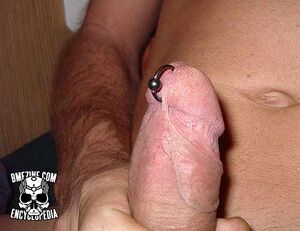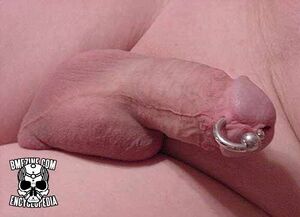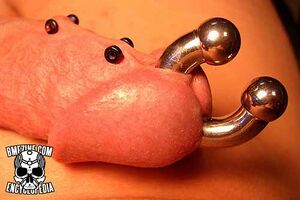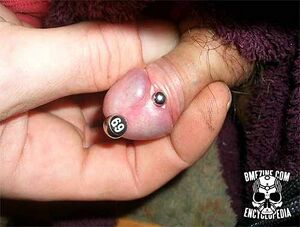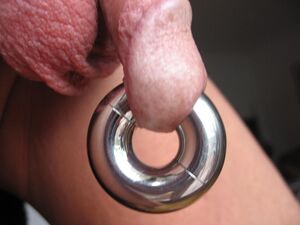Prince Albert and Prince Albert Piercing: Difference between pages
(Page conversion via llm-mediawiki-rev -jwm) |
(Page conversion via llm-mediawiki-rev -jwm) |
||
| Line 1: | Line 1: | ||
[[File: | [[File:Princealbertcartoon.gif|thumb|right|80px]] | ||
[[File:Prince_Albert_Piercing-1.jpg|thumb|right|Prince Albert Piercing]] | |||
[[File:Prince_Albert_Piercing-2.jpg|thumb|right|Prince Albert Piercing]] | |||
[[File:Prince_Albert_Piercing-3.jpg|thumb|right|Prince Albert Piercing]] | |||
[[File:Prince_Albert_Piercing-4.jpg|thumb|right|Prince Albert Piercing]] | |||
[[File:Prince_Albert_Piercing-5.jpg|thumb|right|Prince Albert Piercing]] | |||
=Contents= | |||
* 1 [[#Headline_text|Headline text]] | |||
* 2 [[#Placement|Placement]] | |||
* 3 [[#Procedure|Procedure]] | |||
* 4 [[#Healing_and_aftercare|Healing and aftercare]] | |||
* 5 [[#Long-term_health_issues|Long-term health issues]] | |||
* 6 [[#Jewelry|Jewelry]] | |||
* 7 [[#History_and_culture|History and culture]] | |||
* 8 [[#Related_Articles|Related Articles]] | |||
=Headline text= | |||
A '''Prince Albert Piercing''' (PA) is one of the most common [[Male_genital_piercing|male genital piercings]]. It heals quickly and is relatively trouble-free. Many men also find it to be one of the least painful male genital piercings, although pain is subjective — some men report some degree of pain, while others compare it to a light pinch or feel hardly anything at all). | |||
== | There is also the “[[Reverse_Prince_Albert_piercing|reverse Prince Albert piercing]],” which enters through the urethra and exits through a hole pierced at the top of the [[Glans|glans]]. | ||
=Placement= | |||
The PA pierces the [[Penis|penis]] from the outside of the [[Frenum|frenulum]] and into the [[Urethra|urethra]]. In a circumcised male, this can be done directly through the center of the [[Frenum|frenulum]], but this is not the case for an uncircumcised male. The proper placement in an uncircumcised male is off to one side (usually to the side he dresses to) of the [[Frenum|frenulum]]'s ridge, just behind the [[Glans|glans]], placing the ball of a barbell behind the [[Glans|glans]] and underneath the foreskin when the foreskin is pulled forward. | |||
=Procedure= | |||
During the process of any Prince Albert piercing, the area is first cleaned and marked at the piercing point. An uncircumcised male will be required to pull his foreskin back so the best placement can be determined. In uncircumcised men the piercing is usually done to one side of the [[Frenum|frenum]] to prevent discomfort. | |||
There are several different methods used to perform this piercing, the most common of which is to insert a [[Receiving_tube|receiving tube]] into the [[Urethra|urethra]] and then pierce from the chosen point on the outside — some piercers mark this point, some don't — into the recieving tube. The tube is then removed, and the chosen jewellery is inserted behind the needle. | |||
Alternatively, a [[Cannula|cannula]] can be used to perform the piercing from the inside out. The needle is retracted slightly, and the cannula is inserted into the urethra and lined up with the exit mark on the outside. The needle is then pushed down into the cannula, and the whole lot is pushed out through the exit point. After the needle is removed the cannula remains in place, allowing for very easy jewellery insertion. | |||
A third method is occasionally used by very experienced [[Freehand_Piercing|freehand]] piercers, who use a method similar to the cannula method explained above, but using a standard [[Piercing_needle|piercing needle]]. With great care the needle can be inserted into the urethra and the piercing done from the inside out. This method is only used by people with a lot of experience and confidence, as great care must be taken not to nick the inside of the urethra. | |||
=Healing and aftercare= | |||
Recommended cleaning is a daily sea salt and water soak as well as washing the area with a mild soap once or twice a day, making sure to clean and dry the area thoroughly. In an uncircumcised male it is generally more comfortable to have the foreskin sitting forward covering the [[Glans|glans]], but this holds in moisture and is generally not good for a healing piercing — the new piercing should be checked often to be kept dry. Be prepared for a slight discomfort in the area at the base of the foreskin where the jewelry rubs the foreskin. | |||
=Long-term health issues= | |||
Most wearers discover that wearing a ring in their urethra affects the [[Urine|urine]] stream — the liquid exiting the glans tends to follow the ring downward and "fans" the stream out in a way that is difficult to control, resulting in the need to sit down to urinate. This can present problems in some settings in which a toilet isn't readily available, such as in pubs or outdoor venues. Some men may also have to sit down to urinate due to leaking, or even a full second stream, of urine exiting through the piercing hole simultaneously with the normal urethral opening at the front of the penis. Some men can successfully stand to urinate by using a wall urinal and turning their penis so that the head is upside-down, even if they have two streams. | |||
=Jewelry= | |||
This piercing is usually performed at 10 gauge or larger, and most men who have it done find that the piercing [[Stretch|stretches]] very quickly and easily on its own. Opinions vary as to what most men — and their partners — find ideal in size both for comfort and for the sensations produced, but jewelry withing the 8ga to 2ga range seem the most popular. For some people, the piercing is purely aesthetic, but for others, it is highly sensual. It should be noted that some women find this piercing, in any gauge, uncomfortable during sex. Others may not even notice it at all. | |||
=History and culture= | |||
A lot has been written about the history of the Prince Albert piercing, but very little of it is true. The most common story is that it was a so-called "dressing ring," used to pull the penis into tight fitting fashions, and that [[Prince_Albert|Prince Albert]] himself had one. Others have suggested than he wore it to keep his [[Foreskin|foreskin]] retracted and "fresh smelling" so as not to offend his Queen. | |||
Others, most notably [[Doug_Malloy|Doug Malloy]], have suggested that it was worn by divers to hold onto a urine trap as an alternative to a [[Catheter|catheter]]. Doug Malloy also stated that Italian Fascist dictator Benito Mussolini wore a Prince Albert and had a hole cut in his pocket to easily access the piercing — apparently Il Duce would tug on his P.A. in times of stress to calm himself. | |||
Another amusing but also ''likely'' fictitious story is that Germanic warriors of the late medieval period wore these genital piercings in order to pull their genitals tightly between their legs in order to avoid sword injuries during combat. Whether this story is true or simply an excuse for those with Germanic heritage to boast about their masculinity (see: [[Dueling_scar|dueling scar]]) is up for debate. | |||
There is no conclusive evidence that any of this is true. | |||
=Related Articles= | |||
* [[Reverse_PA|Reverse PA]] | |||
* [[Prince's_Wand|Prince's Wand]] | |||
* [[Male_Genital_Piercings|Male Genital Piercings]] | |||
Latest revision as of 10:07, 17 September 2023
Contents
- 1 Headline text
- 2 Placement
- 3 Procedure
- 4 Healing and aftercare
- 5 Long-term health issues
- 6 Jewelry
- 7 History and culture
- 8 Related Articles
Headline text
A Prince Albert Piercing (PA) is one of the most common male genital piercings. It heals quickly and is relatively trouble-free. Many men also find it to be one of the least painful male genital piercings, although pain is subjective — some men report some degree of pain, while others compare it to a light pinch or feel hardly anything at all).
There is also the “reverse Prince Albert piercing,” which enters through the urethra and exits through a hole pierced at the top of the glans.
Placement
The PA pierces the penis from the outside of the frenulum and into the urethra. In a circumcised male, this can be done directly through the center of the frenulum, but this is not the case for an uncircumcised male. The proper placement in an uncircumcised male is off to one side (usually to the side he dresses to) of the frenulum's ridge, just behind the glans, placing the ball of a barbell behind the glans and underneath the foreskin when the foreskin is pulled forward.
Procedure
During the process of any Prince Albert piercing, the area is first cleaned and marked at the piercing point. An uncircumcised male will be required to pull his foreskin back so the best placement can be determined. In uncircumcised men the piercing is usually done to one side of the frenum to prevent discomfort.
There are several different methods used to perform this piercing, the most common of which is to insert a receiving tube into the urethra and then pierce from the chosen point on the outside — some piercers mark this point, some don't — into the recieving tube. The tube is then removed, and the chosen jewellery is inserted behind the needle.
Alternatively, a cannula can be used to perform the piercing from the inside out. The needle is retracted slightly, and the cannula is inserted into the urethra and lined up with the exit mark on the outside. The needle is then pushed down into the cannula, and the whole lot is pushed out through the exit point. After the needle is removed the cannula remains in place, allowing for very easy jewellery insertion.
A third method is occasionally used by very experienced freehand piercers, who use a method similar to the cannula method explained above, but using a standard piercing needle. With great care the needle can be inserted into the urethra and the piercing done from the inside out. This method is only used by people with a lot of experience and confidence, as great care must be taken not to nick the inside of the urethra.
Healing and aftercare
Recommended cleaning is a daily sea salt and water soak as well as washing the area with a mild soap once or twice a day, making sure to clean and dry the area thoroughly. In an uncircumcised male it is generally more comfortable to have the foreskin sitting forward covering the glans, but this holds in moisture and is generally not good for a healing piercing — the new piercing should be checked often to be kept dry. Be prepared for a slight discomfort in the area at the base of the foreskin where the jewelry rubs the foreskin.
Long-term health issues
Most wearers discover that wearing a ring in their urethra affects the urine stream — the liquid exiting the glans tends to follow the ring downward and "fans" the stream out in a way that is difficult to control, resulting in the need to sit down to urinate. This can present problems in some settings in which a toilet isn't readily available, such as in pubs or outdoor venues. Some men may also have to sit down to urinate due to leaking, or even a full second stream, of urine exiting through the piercing hole simultaneously with the normal urethral opening at the front of the penis. Some men can successfully stand to urinate by using a wall urinal and turning their penis so that the head is upside-down, even if they have two streams.
Jewelry
This piercing is usually performed at 10 gauge or larger, and most men who have it done find that the piercing stretches very quickly and easily on its own. Opinions vary as to what most men — and their partners — find ideal in size both for comfort and for the sensations produced, but jewelry withing the 8ga to 2ga range seem the most popular. For some people, the piercing is purely aesthetic, but for others, it is highly sensual. It should be noted that some women find this piercing, in any gauge, uncomfortable during sex. Others may not even notice it at all.
History and culture
A lot has been written about the history of the Prince Albert piercing, but very little of it is true. The most common story is that it was a so-called "dressing ring," used to pull the penis into tight fitting fashions, and that Prince Albert himself had one. Others have suggested than he wore it to keep his foreskin retracted and "fresh smelling" so as not to offend his Queen.
Others, most notably Doug Malloy, have suggested that it was worn by divers to hold onto a urine trap as an alternative to a catheter. Doug Malloy also stated that Italian Fascist dictator Benito Mussolini wore a Prince Albert and had a hole cut in his pocket to easily access the piercing — apparently Il Duce would tug on his P.A. in times of stress to calm himself.
Another amusing but also likely fictitious story is that Germanic warriors of the late medieval period wore these genital piercings in order to pull their genitals tightly between their legs in order to avoid sword injuries during combat. Whether this story is true or simply an excuse for those with Germanic heritage to boast about their masculinity (see: dueling scar) is up for debate.
There is no conclusive evidence that any of this is true.

